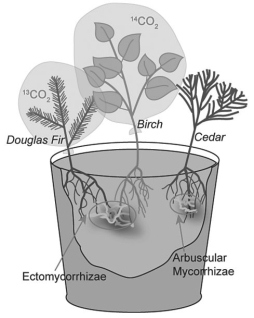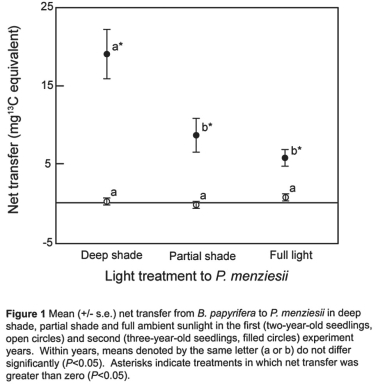Use the following information when answering the corresponding question(s) .
Suzanne Simard and colleagues knew that the same mycorrhizal fungal species could colonize multiple types of trees.They wondered if the same fungal individual would colonize different trees,forming an underground network that potentially could transport carbon and nutrients from one tree to another (S.Simard et al.1997.Net transfer of carbon between mycorrhizal tree species in the field.Nature 388:579-82) .Figure 31.2 illustrates the team's experimental setup.Pots containing seedlings of three different tree species were set up and grown under natural conditions for three years;two of the three species formed ectomycorrhizae (Douglas fir,birch) and the other (cedar) formed arbuscular mycorrhizae.For the experiment,the researchers placed airtight bags over the Douglas fir and birch seedlings;into each bag,they injected either carbon dioxide made from carbon-13 or carbon-14 (¹³CO₂ and ¹⁴CO₂,isotopes of carbon) .As the seedlings photosynthesized,the radioactive carbon dioxide was converted into radioactively labeled sugars that could be tracked and measured by the researchers.
Figure 31.2

Figure 31.3

-Referring to Simard et al.(1997) ,which design element is the control in this experiment and why?
Definitions:
Oldowan Tool Tradition
The first stone tool industry beginning between 2.5 and 2.6 million years ago.
Human Ancestors
Prehistoric beings and early hominids that preceded and contributed genetically and behaviorally to the modern human species.
Homo Habilis
An extinct species of early humans, known for its use of basic stone tools, living approximately 2.1 to 1.5 million years ago.
Australopithecines
A genus of hominids that lived in Africa between about 4 to 2 million years ago, known for walking upright and being a direct ancestor of modern humans.
Q2: In what way are monotremes similar to
Q5: An organic solvent widely used in industrial
Q5: Which of the following protist lineages is
Q7: Plant and animal development share a number
Q8: Refer to the paragraph on Krings et
Q10: Why might retroviral vectors for gene therapy
Q28: If a scientist needs to put new
Q34: You buy some fresh fruit at the
Q34: What do all sponges have in common?<br>A)They
Q35: Refer to the paragraph on how caterpillar-damaged